Disclosure: We may earn commissions if you purchase products after clicking on a link from our site.
Do you want more excitement with game fish? Do you want to fish for one of the hardest-fighting fish in North America? Would you like to learn how to catch smallmouth bass? Despite its size, many anglers will attest that smallmouth bass with give you a fight that you least expected for its size.
In this article, we discuss how to catch smallmouth bass, tips and techniques, baits and lures,
as well as fishing tackle to be successful with it.
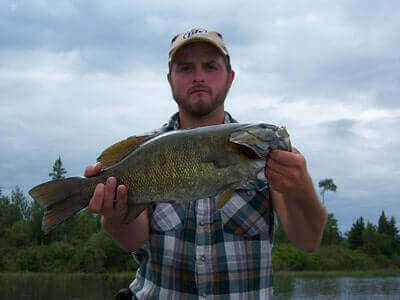
Table of Contents
- 1 How To Catch Smallmouth Bass
- 2 Best Baits For Smallmouth Bass
- 3 Best Lures For Smallmouth Bass
- 4 Smallmouth Bass Fishing Tackle
- 5 How To Catch Smallmouth Bass In Rivers
- 6 How To Catch Smallmouth Bass In Creeks
- 7 How To Catch Smallmouth Bass In Early Spring
- 8 How To Catch Smallmouth Bass From Shore
- 9 Largemouth Bass vs Smallmouth Bass
- 10 Smallmouth Bass Fishing Tips
- 11 The Bottom Line
How To Catch Smallmouth Bass
Smallmouth bass like to be around large-sized rocks, reefs, shoals, and expansive flats. When fishing for smallmouth bass, the water temperature and time of the year will be the factors that influence smallmouth bass behavior. They are always moving and you will have to adjust your fishing to their behavior.
Additionally, they like clean and clear water. if the water is not deep, and you can’t see the bottom, there is a strong chance that they are not in there.
1. Casting and Retrieving
Casting and retrieving is a popular method for catching smallmouth bass, especially in freshwater lakes, rivers, and streams. Anglers typically use a variety of lures such as crankbaits, spinnerbaits, and soft plastic baits to mimic the movements of small fish or insects, enticing the bass to strike.
This technique involves casting the lure out into the water, allowing it to sink to the desired depth, and then retrieving it with a steady or erratic motion to imitate prey movement. By varying the speed and action of the retrieve, anglers can effectively target smallmouth bass in different water depths and conditions. Casting and retrieving is a versatile and active fishing method that allows anglers to cover a lot of water and explore various areas where smallmouth bass may be feeding.
2. Bottom Fishing
Bottom fishing is a reliable and effective fishing method for catching smallmouth bass, particularly in deeper waters or around rocky structures and drop-offs. This technique involves presenting bait or lures directly on or near the bottom of the water column, where smallmouth bass often forage for food.
Anglers typically use a variety of baits such as live baitfish, nightcrawlers, or crayfish rigged on a bottom rig or jig, or they may opt for soft plastic baits like tubes or crawfish imitations. To successfully catch smallmouth bass using bottom fishing, anglers must locate potential bass-holding areas, such as submerged rock piles, ledges, or deep holes, using a fish finder or by studying underwater topography.
Once in position, anglers can drop their bait or lure to the bottom and slowly jig or bounce it along the substrate to mimic natural movements and entice strikes from feeding bass. Bottom fishing for smallmouth bass requires patience and finesse, as anglers must carefully monitor their line for subtle bites and adjust their presentation to match the bass’s feeding behavior. By employing this method with the right gear and bait, anglers can effectively target and catch smallmouth bass in a variety of freshwater environments.
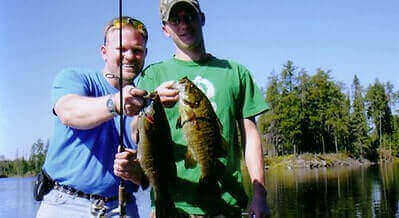
3. Vertical Jigging
Vertical jigging is a highly effective fishing method for catching smallmouth bass, especially in deeper waters or around submerged structures such as rock piles or drop-offs. This technique involves dropping a jig or soft plastic bait directly beneath the boat and jigging it vertically through the water column to entice strikes from bass holding near the bottom.
To successfully catch smallmouth bass using vertical jigging, anglers must first locate potential bass-holding areas using a fish finder or by observing underwater features such as ledges, submerged trees, or boulder fields. Once in position, anglers can drop their jig or bait to the desired depth and employ a rhythmic jigging motion to impart lifelike movements and attract the attention of nearby bass.
By varying the speed, cadence, and depth of their jigging, anglers can effectively target smallmouth bass at different levels of the water column and trigger strikes from wary fish. Vertical jigging requires patience, precision, and attention to detail, as anglers must closely monitor their line for subtle bites and adjust their presentation accordingly. With practice and persistence, vertical jigging can be a highly rewarding method for catching smallmouth bass in a variety of freshwater environments.
4. Fly Fishing
Fly fishing is a rewarding and challenging method for catching smallmouth bass, offering anglers a unique and immersive fishing experience. To effectively catch smallmouth bass using fly fishing techniques, anglers must first select the appropriate fly patterns and gear tailored to the specific conditions and behaviors of the bass.
Streamers, poppers, and crayfish imitations are popular fly patterns for targeting smallmouth bass, mimicking the natural prey items that bass feed on. Anglers must then present their fly accurately and effectively to entice strikes from smallmouth bass. This often involves casting the fly near structures such as rocky banks, submerged logs, or riffles where bass are likely to be holding.
By mastering casting techniques such as roll casts, overhead casts, and mending, anglers can present their fly in a lifelike manner and effectively target smallmouth bass in various water conditions. Fly fishing for smallmouth bass requires patience, precision, and finesse, as anglers must carefully control their fly line and manipulate their fly to entice strikes from wary fish. With practice and perseverance, fly fishing can be a highly rewarding method for catching smallmouth bass and enjoying the beauty and serenity of freshwater environments.
5. Topwater Fishing
Topwater fishing is an exciting and visually stimulating method for catching smallmouth bass, particularly during the warmer months when bass are actively feeding near the surface. Anglers typically use topwater lures such as poppers, frogs, or propeller baits that create surface disturbance and mimic the movements of injured baitfish or frogs.
This technique involves casting the lure out onto the water’s surface and using a series of twitches or pops to create splashes and commotion, attracting the attention of nearby bass. When a bass strikes, the angler must wait for a moment before setting the hook, allowing the bass to fully engulf the lure.
Topwater fishing requires patience and precise timing, as strikes can be explosive and exhilarating, making it a thrilling way to catch smallmouth bass in shallow water or around submerged structures. Topwater fishing is an excellent choice for anglers looking for an adrenaline-filled fishing experience and is particularly effective during low-light conditions or in areas with dense surface cover.
6. Drifting
Drifting with live bait is another effective method for catching smallmouth bass, particularly in rivers and streams with moderate current flow. Anglers typically use live bait such as nightcrawlers, minnows, or crayfish rigged on a hook or jig and allow them to drift naturally with the current.
This technique requires anglers to position their boat or kayak upstream from potential bass-holding areas, and then allow the bait to drift downstream while maintaining contact with the bottom. By presenting live bait naturally and enticingly, anglers can entice smallmouth bass to strike, especially in areas with rocky structures, submerged logs, or other cover where bass are likely to ambush prey.
Drifting with live bait is a patient and strategic approach that can yield excellent results, particularly in riverine environments where smallmouth bass are abundant.
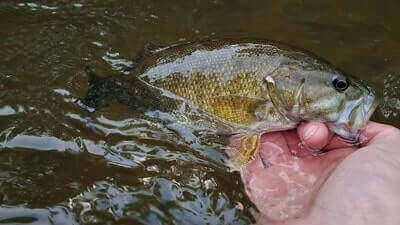
Best Baits For Smallmouth Bass
- Crawfish
Crayfish are highly effective bait for targeting smallmouth bass due to their natural appeal and resemblance to a primary food source for bass. Smallmouth bass are opportunistic predators and readily consume crayfish as part of their diet, making them an enticing bait option for anglers.
To use crayfish as bait for smallmouth bass, anglers typically rig them on a hook or jighead and present them near rocky bottoms, submerged structures, or along drop-offs where bass are likely to be foraging. Live crayfish can be particularly effective, as they exhibit natural movements and behaviors that attract the attention of nearby bass.
However, artificial crayfish lures such as soft plastics or crankbaits can also be productive alternatives, especially when live crayfish are not available. Anglers should experiment with different presentation techniques, such as bouncing the crayfish along the bottom or retrieving it with short, erratic twitches, to mimic the natural movements of crayfish and entice strikes from smallmouth bass.
Overall, crayfish are a versatile and reliable bait option for targeting smallmouth bass, offering anglers a realistic and effective means of enticing these prized freshwater gamefish.
2. Minnows
Minnows are a popular and effective bait choice for targeting smallmouth bass, offering anglers versatility and reliability in enticing strikes from these prized freshwater gamefish. Anglers can catch smallmouth bass using minnows by rigging them on a hook or jighead and presenting them near areas where bass are likely to be feeding, such as rocky bottoms, submerged structures, or along weed lines.
Live minnows, such as shiners or chubs, are particularly effective as they exhibit natural swimming movements and behaviors that attract the attention of nearby bass. Alternatively, anglers can use artificial minnow lures, such as crankbaits or swimbaits, to mimic the appearance and actions of live minnows.
When using live minnows as bait for smallmouth bass, anglers should ensure they are properly rigged to allow for natural movement and presentation. This may involve hooking the minnow through the lips, dorsal fin, or tail, depending on the desired swimming action and depth of the water. By experimenting with different rigging techniques and presentation methods, anglers can effectively use minnows as bait to catch smallmouth bass in a variety of freshwater environments.
3. Aquatic Insects
Aquatic insects serve as a natural and effective bait for targeting smallmouth bass, providing anglers with an opportunity to mimic the bass’s natural prey and entice strikes in freshwater environments. To catch smallmouth bass using aquatic insects as bait, anglers can employ various techniques to present the insects in a lifelike manner.
One common method is fly fishing, where anglers use artificial fly patterns that imitate aquatic insects such as mayflies, caddisflies, or stoneflies. These fly patterns can be cast onto the water’s surface or drift through currents to mimic the natural movements of insects and attract the attention of nearby bass.
Additionally, anglers can use live aquatic insects, such as hellgrammites, stonefly nymphs, or caddisfly larvae, rigged on a hook or jighead to target smallmouth bass. These live baits can be presented near rocky bottoms, submerged structures, or along riffles and eddies where bass are likely to be foraging. By presenting aquatic insects naturally and enticingly, anglers can effectively catch smallmouth bass and enjoy the thrill of fishing with natural bait in freshwater environments.
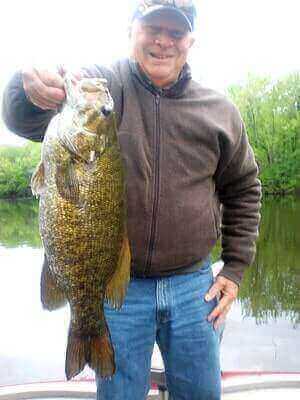
Best Lures For Smallmouth Bass
- Jigs
Jigs are versatile and highly effective lures for catching smallmouth bass, offering anglers a reliable option for targeting these prized freshwater gamefish in a variety of conditions. To catch smallmouth bass using jigs as lures, anglers can employ several techniques to present the lure in a lifelike manner and entice strikes.
One popular method is vertical jigging, where anglers drop a jig directly beneath the boat and jig it vertically through the water column to mimic the natural movements of baitfish or crayfish. This technique requires anglers to locate potential bass-holding areas, such as rocky structures, drop-offs, or submerged brush piles, using a fish finder or by observing underwater features.
Once in position, anglers can jig the lure with short, upward movements to create enticing vibrations and trigger strikes from nearby bass. Additionally, anglers can cast jigs along rocky shorelines, submerged points, or around boat docks and other structures where smallmouth bass are likely to be holding.
By varying the retrieve speed, depth, and jigging motion, anglers can effectively target smallmouth bass in different water depths and conditions. Overall, jigs are a versatile and productive lure option for catching smallmouth bass, offering anglers a realistic and enticing presentation that can yield excellent results in a variety of freshwater environments.
2. Topwater Lures
Topwater lures are exhilarating and effective options for catching smallmouth bass, providing anglers with an exciting fishing experience that often results in explosive strikes. To catch smallmouth bass using topwater lures, anglers can employ several techniques to present the lure in a manner that entices strikes from these prized freshwater gamefish.
One popular method is “walk-the-dog,” where anglers use lures such as poppers, prop baits, or stick baits to create a side-to-side, zigzagging motion across the water’s surface. This technique mimics the movements of wounded or struggling prey and can attract aggressive strikes from nearby bass.
Another effective method is “plopping,” where anglers use lures such as buzz baits or frogs to create loud splashes and commotion on the water’s surface. This technique can draw attention from bass in the area and provoke aggressive strikes.
Additionally, anglers can use topwater lures around shallow cover such as rocky shorelines, submerged vegetation, or boat docks where smallmouth bass are likely to be holding. By experimenting with different topwater lures and presentation techniques, anglers can effectively target smallmouth bass and enjoy the thrill of fishing with surface lures in freshwater environments.
3. Crankbaits
Crankbaits are versatile and effective lures for catching smallmouth bass, offering anglers a reliable option for targeting these prized freshwater gamefish in a variety of conditions. To catch smallmouth bass using crankbaits, anglers can employ several techniques to present the lure in a manner that entices strikes.
One popular method is casting crankbaits along rocky shorelines, submerged structures, or drop-offs where smallmouth bass are likely to be holding. Anglers can vary the retrieve speed and depth to mimic the movements of injured baitfish or crayfish, enticing strikes from nearby bass.
Additionally, anglers can troll crankbaits behind a boat or kayak to cover larger areas of water and locate active fish. When using crankbaits to catch smallmouth bass, anglers should experiment with different colors, sizes, and diving depths to match the prevailing conditions and preferences of the fish. By understanding the behavior and habitat preferences of smallmouth bass, anglers can effectively use crankbaits to target these prized gamefish and enjoy success in freshwater environments.
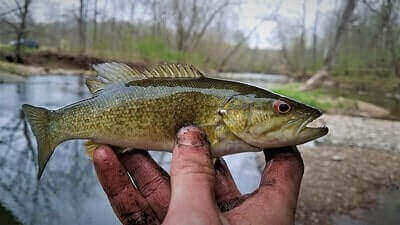
4. Small Plastic Worms
Small plastic worms are effective and versatile lures for catching smallmouth bass, offering anglers a reliable option for enticing strikes in various freshwater environments. To catch smallmouth bass using small plastic worms, anglers can employ several techniques to present the lure in a manner that mimics natural prey and attracts the attention of bass.
One popular method is Texas rigging, where anglers rig the plastic worm weedless on a hook and cast it around submerged vegetation, rocky bottoms, or other structures where smallmouth bass are likely to be holding. Anglers can then retrieve the worm with a slow, subtle motion, allowing it to sink and undulate naturally through the water column.
Additionally, anglers can use techniques such as Carolina rigging or drop shotting to present small plastic worms near the bottom, enticing strikes from bass feeding on or near the substrate. By experimenting with different colors, sizes, and rigging techniques, anglers can effectively target smallmouth bass and enjoy success using small plastic worms as lures.
For more information on fishing regulations and best practices for catching smallmouth bass, anglers can visit the official website of the United States Fish and Wildlife Service at https://www.fws.gov/.
5. Swimbaits
Swimbaits are highly effective lures for targeting smallmouth bass, providing anglers with a realistic and enticing presentation that can entice strikes from these prized freshwater gamefish. To catch smallmouth bass using swimbaits, anglers can employ several techniques to present the lure in a manner that mimics the natural movements of baitfish and attracts the attention of bass.
One popular method is slow and steady retrieval, where anglers cast the swimbait out onto the water and retrieve it with a smooth and consistent motion. This technique allows the swimbait to glide through the water column, imitating the swimming action of injured or fleeing baitfish and enticing strikes from nearby bass.
Additionally, anglers can use techniques such as jigging or hopping to impart erratic movements and trigger reaction strikes from aggressive bass. By experimenting with different sizes, colors, and retrieval speeds, anglers can effectively target smallmouth bass and enjoy success using swimbaits as lures. Learning how to catch smallmouth bass with swimbaits can enhance angler success and provide an exciting fishing experience in freshwater environments.
Smallmouth Bass Fishing Tackle
Regular fishing rods with lengths in the range of 7 to 71/2 ft will work. Additionally, many anglers opt for baitcasting reels when fishing for smallmouth bass. Spin-casting reels also work when fishing for smallmouth bass.
Braided lines with a minimum of 15 lb test are the trend now over mono lines, especially if you will fish this fish around heavy cover. A good cast net and needle nose pliers are always good to have when fishing ut much more when learning how to catch smallmouth bass. if you are interested in cast nets and fishing pliers, you can read the best cast nets and the best fishing pliers.
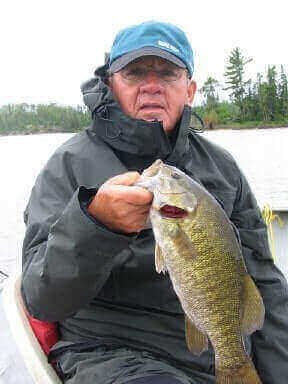
How To Catch Smallmouth Bass In Rivers
When fishing for smallmouth bass in rivers, look for rock piles, expansive flats, rocky points, reefs, and shoals. By studying the surface of the water, you can spot isolated swirls and ripples which may indicate where sizeable rocks and other objects are located.
Smallmouth bass will usually be found around these structures. You can cast your baits or lures into these areas to get a bite. Bottom fishing can also be used to catch smallmouth bass when they move into deeper water.
How To Catch Smallmouth Bass In Creeks
Fishing for smallmouth bass in creeks is a little different than fishing in rivers, or lakes. Fishing in the creek is influenced by the moving water. When fishing for smallmouth bass in creeks, look for eddies, pools, and undercut banks.
Use baits such as crayfish and minnows when casting for smallmouth bass or lures of crayfish and minnows to catch smallmouth bass. Make a short cast since setting the hook in current is not the easiest of fishing tasks.
How To Catch Smallmouth Bass In Early Spring
Smallmouth bass fishing is influenced by two factors: water temperature and the time of the year. In early spring, smallmouth bass will start preparing for the spawning period by moving to secondary points. They spawn from 1-foot of water to 20 feet. After the spawning season, smallmouth bass will move to 8 to 10 feet in the water column to get ready for summer.
With this knowledge of their movements, you can cast your baits to these water depths to catch smallmouth bass. Crayfish or baitfish can be used to target smallmouth bass in early spring or spring.
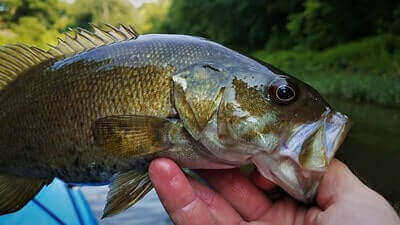
How To Catch Smallmouth Bass From Shore
Fishing for smallmouth bass from the shore can also be done by casting baits and lures to areas where they are maybe hanging out. Rocky shorelines, shallow rocky shoals, drop-offs, reefs, and eddies are areas where smallmouth bass can be found. Casting your bait into these areas increases your chances of catching them.
When fishing from the shore, study the water to identify drop-offs, deep holes, and other areas that smallmouth bass may be hanging out in.
Largemouth Bass vs Smallmouth Bass
| Largemouth Bass | Smallmouth Bass | |
|---|---|---|
| Habitat | Shallow underwater grasslands | Rocky shoals at the bottom |
| Easily Found | Yes | No |
| Fishing | Casting baits & lures | Deep water techniques |
| Size | Over 10 lbs | 10 lbs or less |
| Length | 15-30 inches | 10-20 inches long |
| Appearance | No vertical lines; speckled green body |
Vertical lines on the body |
| Best Time to Fish | Summertime | Spring or Fall |
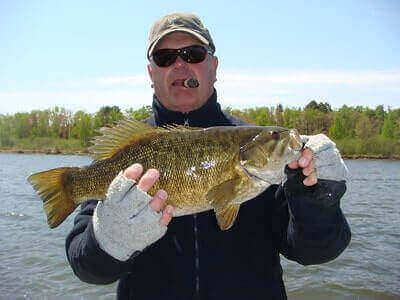
Smallmouth Bass Fishing Tips
- Smallmouth bass can be found in shallow rocky shoals, reefs, drop-offs, eddies, and pools.
2. Smallmouth bass doesn’t have great vision like other fish. However, they are driven by smell and sound.
3. Keep your bait close to the bottom as smallmouth bass will be preying on marine life close to the bottom.
4. Smallmouth bass are easy to catch but difficult to find.
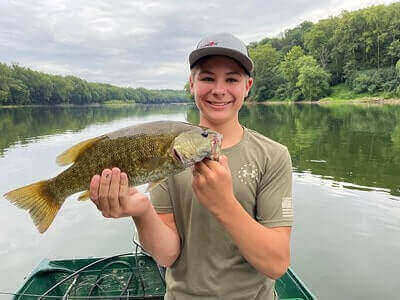
5. Smallmouth bass like cold running water. When fishing for smallmouth bass, look for clearwater streams and small rivers.
6. Target areas with large rocks at the bottom of clear lakes and streams.
7. Smallmouth bass has a good sense of smell and is attracted to scents like garlic.
8. When the temperature goes below 60 degrees in clear water, smallmouth bass hibernates.

9. Smallmouth bass can’t spawn in unclean water.
10. Smallmouth bass comes to the surface early in the morning for feeding. When fishing shallow streams, be careful about casting a shadow.
11. Smallmouth bass like clear water. For a body of water that is not deep, if you can’t see the bottom of the water, chances are smallmouth bass is not in it.
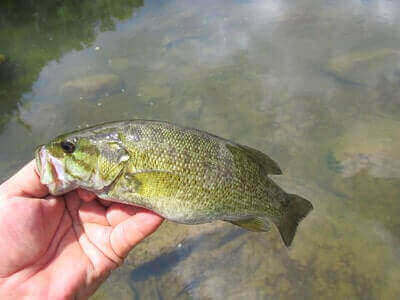
The Bottom Line
Smallmouth bass are not the favorite bass that most anglers like to fish. However, they a good sport fish that will test your fishing skills to locate them and get them to bite your presentation.
In this article, we discussed how to catch smallmouth bass, the fishing methods that work in different situations to catch this fish, as well as the best baits and lures to use. You can also read how to catch largemouth bass to pick up a few tips to enhance your fishing skills to land more largemouth bass.
You can also read how to catch largemouth bass, how to catch white bass, how to catch yellow bass, and how to catch black sea bass.